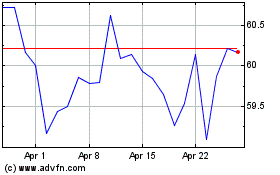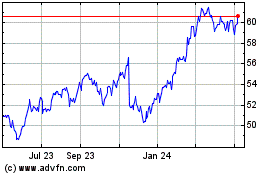Would a TikTok Ban Make the App Disappear? It's Complicated
September 13 2020 - 12:20PM
Dow Jones News
By Sebastian Herrera
For the millions of TikTok users in the U.S., an important
deadline looms. An executive order issued by President Trump Aug. 6
gave ByteDance Ltd., the Chinese parent of the popular video app,
45 days to sell its U.S. operations to an American company or face
a ban. A subsequent presidential order gave companies until Nov. 12
for a transaction to be finalized.
It is likely that the tight timeline won't be met, as ByteDance
has discussed with the U.S. government possible arrangements that
would allow the app to avoid a full sale, according to people
familiar with the matter. Deal talks have hit a snag due to new
Chinese rules that appear to have made a sale more difficult.
Microsoft Corp., with its partner Walmart Inc., has been a
leading company involved in discussions to buy part of TikTok.
Another group formed by Oracle Corp. and some of ByteDance's
investors, including Sequoia Capital, General Atlantic and Coatue
Management LLC, have also been part of the discussions.
While President Trump has said TikTok would be banned from the
U.S. if a sale is not made by the Sept. 15 deadline, experts say
the reality is that TikTok is unlikely to disappear in the coming
weeks.
Here is more on what this means for TikTok users and followers
in the U.S.
Will TikTok be unusable in the U.S. after the deadline?
Unlike in India, which banned TikTok and other Chinese apps
through government authority that can force internet service
providers to prevent users from accessing certain websites, no such
authority exists in the U.S, experts say. "The sanction against
ByteDance should not be able to be used to stop people from using
TikTok for information and communication purposes," said Kurt
Opsahl, general counsel of the Electronic Frontier Foundation, a
San Francisco-based group that advocates for civil liberties in
technology.
While the government may lack that broad authority, U.S.
officials could order Apple Inc. and Google to remove TikTok from
their app stores, Mr. Opsahl said. Such a move would limit the
app's reach by stopping downloads and cutting off software updates,
which over time could affect usability of the app for those who
have it. There are a number of ways the government could pursue an
app-store ban, Mr. Opsahl said, including further defining
restrictions involving TikTok in rules expected to be released
after the deadline. U.S. officials have been vague about how the
government would implement a TikTok shutdown order.
What are Apple and Google planning?
Neither company has publicly outlined plans for TikTok if a deal
is not reached by the deadline. Apple didn't respond to requests
for comment and Google declined to comment.
Avery Gardiner, general counsel at the Center for Democracy
& Technology, said the companies could fight a government ban
by saying that it restricts access to communication under the First
Amendment. Such arguments have prevailed in censorship cases
involving book publishers and newspapers, Ms. Gardiner said. Apple
and Google have generally only banned apps that violate their
platform rules. TikTok filed a lawsuit in August challenging the
president's order, saying then that it had taken vast measures to
protect the privacy and security of user data in the U.S. and
explained those efforts to the government in a security review.
Are there other ways the U.S. could ban TikTok?
Experts say the president's order could also thwart TikTok by
preventing other companies from engaging with the app or providing
it with services, since the order targets transactions with the
company. Like other social-media platforms, TikTok uses
cloud-computing services and sells advertisements. If TikTok were
to have to rely on non-American companies for those services, it
could have a substantial effect on the usability, speed and
security of the app. By attempting to cut off transactions between
American companies and TikTok, the order also threatens TikTok's
advertising revenue from the U.S., experts say.
How will people be able to access TikTok?
Americans might have to become more like Chinese internet users,
some of whom use virtual private networks and set their locations
outside the country to get around China's national internet
firewall, which blocks numerous websites, including Google and
Facebook. Similar VPN workarounds could be an option for U.S.
TikTok users, although it is unclear whether Apple and Google would
also have to cut off TikTok from their stores overseas if required
to remove the app in the U.S. But even if Apple and Google take
TikTok off their platforms, experts say users could still access
TikTok through sideloaded apps, or ones that haven't gone through
Google and Apple's verification processes. This method, however,
could potentially expose users to security vulnerabilities and
malware.
Has anything like this happened before?
The presidential order against TikTok bars people in the U.S. or
subject to U.S. jurisdiction from transactions with ByteDance. The
president used a similar strategy last year in an executive order
that effectively barred U.S. companies from buying
telecommunications network gear and services from Huawei, the
Chinese firm that makes phones, tablets and 5G equipment. As with
TikTok, the government cited national-security concerns. Yet
experts say the U.S. case against Huawei was more easily understood
because Huawei's transactions involve physical hardware and other
equipment.
The forced sale of U.S. operations is highly unusual since it
appears to make it necessary for ByteDance to separate some pieces
of TikTok's business geographically, presenting an unusually thorny
technical challenge. Mr. Trump said on Thursday that the Sept. 15
deadline would not be extended. For now, TikTokers may have to keep
dancing to save their favorite app. Vanessa Pappas, who became the
interim head of TikTok last month after CEO Kevin Mayer abruptly
resigned, told The Wall Street Journal she aims to keep the
platform open, inclusive and as a place for self-expression and
community.
Write to Sebastian Herrera at Sebastian.Herrera@wsj.com
(END) Dow Jones Newswires
September 13, 2020 12:05 ET (16:05 GMT)
Copyright (c) 2020 Dow Jones & Company, Inc.
Walmart (NYSE:WMT)
Historical Stock Chart
From Jun 2024 to Jul 2024

Walmart (NYSE:WMT)
Historical Stock Chart
From Jul 2023 to Jul 2024
